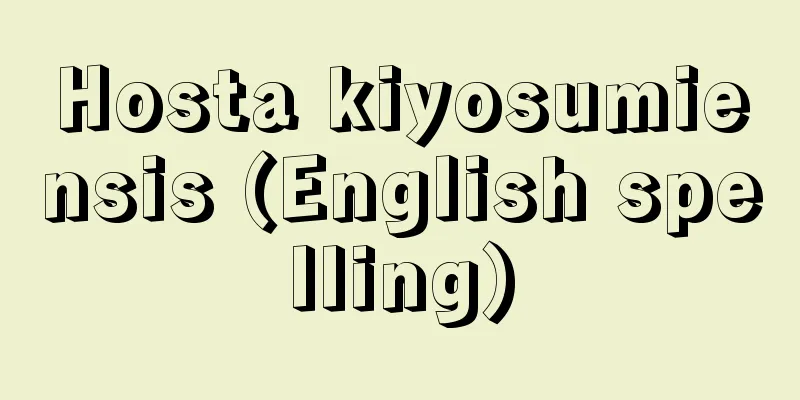Kato Kyodai - Kato Kyodai

|
Year of death: January 20, 1792 (February 12, 1792) Year of birth: September 1, 1732 (October 19, 1732) A haiku poet of the mid-Edo period. His given name was Shukyo, and he was commonly known as Heibei. His other names included Taro and Bougo. He was from Nagoya. His biological father was Kishigami Rinemon, a samurai of the Owari domain. He was adopted by Kato Nakaemon, also a samurai of the domain. He entered the service of the Owari Tokugawa family at the age of 17, retiring at the age of 28. He studied haiku under Muto Hasjaku and Shirani, and after retiring from service to the Owari Tokugawa family, he showed his own unique style. He took the name Bougo Kyodai in "Kaeru Nakishu" (1763), and published "Kosha Bunko" (1768), which strengthened his disciples. He also published "Aki no Hi" (1772). As the Buson school's anthology Akegarasu states, "Owari is already challenging the Five Poetic Immortals with the light of winter sunlight," Aki no Hi was recognized as the beginning of the movement to restore the style of Sho-style. Kyodai's restoration of the style of Sho-style is evident in his journey in 1770 for Shiori Hagi, which follows on from Oku no Hosomichi. Even more noteworthy is that he went to Kyoto accompanied by Sendai's Takeshibabo Hakui, and became friendly with Yosa Buson, with whom he had been exchanging letters for some time. From this point on, his activities began to take a clear direction, leading to the introduction of Kyorai Sho and Atsuta Sankasen (both in 1775) to the world. After that, he visited Tansui in Izumozaki, Echigo, Oshima Ryota in Edo, and Hakui in Sendai. He went to Kyoto several times between 1778 and 1779, but his relationship with Buson was not as close as it had been before. In 1782, he traveled to Edo and planned a trip to the Tohoku and Hokuriku regions, but was forced to abandon the trip due to difficulties in the snowy mountains. He published "Fura Nembutsu" containing haiku poems that he performed during this Kanto pilgrimage as a memorial for Basho. The following year, he performed memorial haiku poems to mark the 100th anniversary of Basho's death at three locations: Genjuan (Gichu-ji Temple) in Konan, Tanryo at Anyoji Temple in Rakuto, and Bashoan at Konpuku-ji Temple. He compiled these and published the volume on the ceremony in "Fura Nembutsu." As he aimed to restore the style of Basho, Gyodai's works began to show a more refined poetic style. They are characterized by the elegance and delicacy of waka poetry. His notable achievements include reprinting and introducing Basho's works, and composing many kana poems. <References> Yamashita Kazukai, "Research on Haikai in the Revival Period - Burukyo Kyodai", Ito Tokichi, "Research on Kyodai" (Kusumoto Sixth Son) Source: Asahi Japanese Historical Biography: Asahi Shimbun Publications Inc. About Asahi Japanese Historical Biography |
|
没年:寛政4.1.20(1792.2.12) 生年:享保17.9.1(1732.10.19) 江戸中期の俳人。名は周挙。通称は平兵衛。別号,他朗,暮雨巷など。名古屋の人。実父は尾張藩士岸上林右衛門。同藩士加藤仲右衛門の養子となる。17歳で尾張徳川家に出仕し,28歳のときに致仕。俳諧は武藤巴雀・白尼に師事し,尾張徳川家致仕後に独自の活動を示す。『蛙啼集』(1763)で暮雨巷暁台を名乗り,『姑射文庫』(1768)刊行に至り,門下は充実する。さらに『秋の日』(1772)を出版。与謝蕪村門の選集『あけ烏』に「既に尾張は五歌仙に冬の日の光を挑んとす」と紹介されるごとく,『秋の日』は蕉風復古運動の嚆矢として評価を得た。暁台の蕉風復古は,明和7(1770)年の『おくのほそ道』のあとを辿った『しをり萩』の旅に顕著である。さらに注目すべきは,仙台の丈芝坊白居を伴って京に上り,かねて文通のあった与謝蕪村と親しく交わったことである。ここにおいて活動は鮮明な方向を示し出し,『去来抄』『熱田三歌仙』(ともに1775)を世に紹介するに至る。 以後,越後出雲崎の旦水,江戸の大島蓼太,仙台の白居のところに足を運んだりした。安永7(1778)年から9年にかけて京に何回か上るが,蕪村との交流は以前ほど親密ではない。天明2(1782)年には江戸の方へ足を運び,東北,北陸までの旅行を企画したが,雪の山中に難渋して断念。この関東地方行脚時に興行した芭蕉忌奉財の俳諧を収めて,『風羅念仏』を刊行。翌年には,湖南幻住庵(義仲寺),洛東安養寺端寮,金福寺芭蕉庵の3カ所で,芭蕉百回忌取越追善俳諧を興行。それらをまとめて,『風羅念仏』法会の巻を刊行。暁台の作品は,蕉風復古を志してより,高雅な詩趣を示すようになる。和歌的優美さや繊細さに特徴がある。芭蕉の作品を翻刻,紹介したこと,仮名詩を多く詠んだことも,特筆すべき実績といえる。<参考文献>山下一海『中興期俳諧の研究―暮雨巷暁台―』,伊藤東吉『暁台の研究』 (楠元六男) 出典 朝日日本歴史人物事典:(株)朝日新聞出版朝日日本歴史人物事典について 情報 |
>>: Movable fangs - Movable fangs
Recommend
Geikie, J.
…In his book published in 1874, British geologist...
Incunabula - incunabula
A general term for printed books published in Euro...
Tibet Expedition - Tibet Exploration
Tibet is a remote region of the world, and it is n...
General meeting of shareholders
Significance and type It is composed of sharehold...
The God of the Land - Aenokuni Tsukami
...It is located in Ichinomiya, Ueno City, Mie Pr...
Zaleukos (English spelling)
A lawgiver in the Greek colony of Locrii (Apoikia)...
Nagawa [town] - Nagawa
A former town in Sannohe County, southeastern Aomo...
Johansen, L.
...A discipline that studies the role of the publ...
Small book - Kohon
〘 noun 〙 (also "kobon") 1. A small book....
Joffre, JJC (English spelling) JoffreJJC
...Meanwhile, the Russian forces led by Generals ...
Ahem - Ahem
...The alcohol content is around 4% (by volume). ...
feedforward control
…In this case, since the system has the configura...
Architect
〘noun〙 (architect) An architect or designer. "...
Gaultier-Garguille (English spelling)
...The latter produced Pierre de Larivey's (c...
Sepioidea
…the general term for the living Sepioidea and Te...









